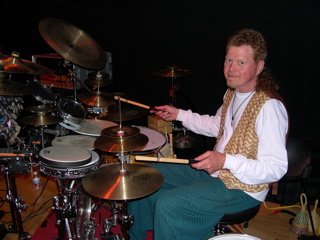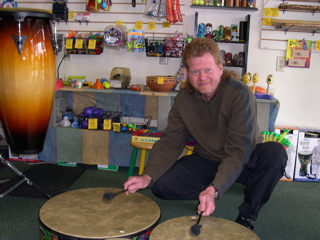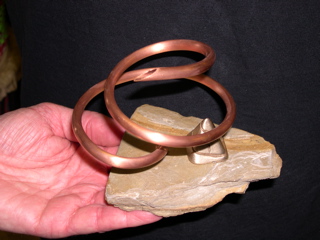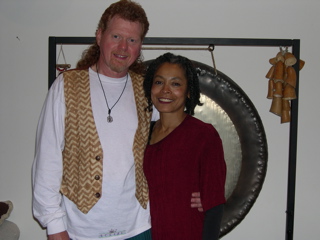
Noisy Toys interviews:
Stephen “Breeze” Smith - Improvisational Drummer
Stephen “Breeze” Smith is a veteran drummer-percussionist who specializes in improvisational performances using drum set, hand percussion, found and manipulated instruments and original textual loops. He is also a visual arts creator, instrument designer and “sound sculptor.” Smith performs in the Los Angeles area with David Ornette Cherry and other improvisational musicians. He also performs with his wife Cheryl Banks-Smith, in their group “ImprovEscapes.” Cheryl is a dance artist who has performed with many innovative performers including Sun Ra, Cecil Taylor and others. She is currently on the faculty at Pasadena City College.

NT - What were the first instruments you were interested in playing? Did you have childhood music classes?
Breeze - The first musical ideas I had were ideas I had in my head. Sounds that I heard in my head. As a young kid experiencing television, radio, that sort of thing, I didn’t hear the instruments I heard in my head, so in the beginning that was sort of an odyssey. It became a search I had to continue on, even though I finally discovered the drum set. My first instrument was actually violin and that was sort of imposed on me by my father.
NT - How old were you then?
Breeze - Seven or eight. That just wasn’t my instrument. I found myself wanting to experiment with that and it was just overwhelming, so the drum set seemed to be what really pulled me in. But there were other environmental sounds that hit me before I could go into those areas. The wind was one of them. Living in Ohio, all these wild, different types of wind sounds were all so different in the various seasons that I was intrigued. Hearing wind go through a pipe and listening to what would happen. Knowing that now, it’s the sound of a flute or a wind instrument. And hearing freight trains, the rhythmic part of freight trains and how they would resonate. Even the empty cars would sound different than the cars that were full, and how they sounded on the tracks and how they sounded from far away and hearing the doppler effect of the whistle ... that kind of thing really fascinated my musical mind.

Stephen “Breeze” Smith at Noisy Toys
NT - So you were interested in sounds of all sorts even from an young age?
Breeze - Oh yeah. I realize now how the environment and nature affected me the same way that I read about how it effected people in other countries, especially the Africans and the Brazilians. All those different people who were so influenced by the natural things around them. In my case it was natural, but it was man made, and it was creating sound.
But to go back to your original question it was the drum set. First of all it looked like a piece of sculpture to me. It looked totally different than any other musical instrument. So I was intrigued. And also knowing that the sound of the freight train doing its’ rhythmic thing, or something like that, could be created with the drum set, interested me.
NT - It sounds like from an early age you were attracted to the physical shapes of things; not only the sounds of things, and that fed into your interest in the artistic part of what you do. Explain how that side of your creativity developed.
Breeze - Coloring books. That was a big thing for me as a kid, like it is for most kids. But those different sized, thick and thin black lines that we were supposed to fill in, or not, or go outside the line. I saw the drum set like that. I saw the shapes; the shapes of the stands and the cymbals. They were like coloring book pages in real life to me, in real form. The other thing about the drum set is that it was not set in stone as to how it was going to be set up. The cymbals could be high, they could be low, they could be tilted. The drums could be more than three or four drums or only one drum. Angled, tilted, or flat, it lent itself to being creative even with the way you approached how you set the instrument up.
NT - What led to you making instruments? Many of your instruments are also like sculptures.

Small metal and rock sculpture created by Breeze
Breeze - When I lived in Europe, I was introduced to a lot of musicians from Turkey and Morocco, and found out the tambourine wasn’t something that was just played the way we heard it in rock and in blues and in R & B. The tambourine had a whole history behind it. When I started learning about that, it just opened up the whole realm of research and culture and cultural connections to the instruments from other countries. Especially the hand percussion instruments. In the mid 1990’s I started working in metal, using the combinations of the drum set and the hand percussion and still continuing with my art forms.
I had a reputation in the metal shop I was working in because I was always banging on things at work. I would hear somebody from way across the room saying, “Hey, Smith. Over here.” And he would be banging on something. I would ask him to save that for me. They would throw it off to the side. So I started collecting things that were going to be thrown away or recycled. As I worked more with welding I started wielding things together making sounds that interested me. In this way I started coming closer and closer to the actual sounds that I had in my head from when I was a kid and couldn’t find the instrument that would equate to that particular sound. So I constructed these musical sculptures that in a performance I was able to create the music I really wanted. That way the rhythms had another whole pallet of colors that I always wanted to reach, but couldn’t.

Breeze presents sculpture to Bill Talbot for Noisy Toys raffle
NT - Describe what these metallic sculptures look and sound like.
Breeze - O.K. They sound like they have an image. So it’s almost like a reversal, because in the beginning it was an image that I was creating in the instrument that had sound. But it then did sort of a flip flop. I may not have said it correctly, but if you can follow me, that’s kind of the way it happened. And people would describe it as sounds from another planet and things like that, and it became a really spacey sort of thing. One person even said I had created an instrument that captured the sounds of the rings of Saturn. (Laughs) Originally I did create sculptures that would work with the environment. They would create sound just by being connected to the wind and rain. They could be left outside and create music on their own as well as they could be played with sticks, mallets, or violin bows.
My father influenced me heavily with his own experimentation, because he played the saw. He didn’t play a musical saw, he played just a regular saw that you would use to cut wood, and he would play it with a violin bow. I’ve been told that an instrument I have called “Zebra Breeze” sounds a little like a musical saw being played with a bow. So the sculptures evolved into the instruments. In fact the “Zebra Breeze” came out of a dream.
I was commissioned to do some musical sculptures. The commission came from a performance I did as a guest artist at Capital University, a music conservatory in Columbus, Ohio, and I was musical guest there for what they called “The Now Festival.” I played five of my sculptures on stage, and through that performance I had my first commission to do an outdoor sound sculpture.
The second commission came from that one, which evolved into the third commission. The third commission is a piece that’s in Alexandria, Virginia. A few days before I was finishing the sculpture I had a dream. In the dream I had this instrument sculpture thing, and I was playing it with a violin bow and striking it with my fingers and mallets. When I woke up I went back to the studio and worked on the sculpture. On the second day as I was finishing the sculpture I was looking around at all the bits and pieces all over the floor, and with welder in hand I thought they looked like some of the shapes of the instrument in the dream. I started welding it together and oddly enough it looked like, and it still sounds like it did initially in the first dream I had.

Breeze and Bill Talbot jam on djembes at Noisy Toys
NT - It sounds like you get inspiration from a lot of different areas.
Breeze - Yes, that’s very true. I’ve done my own self study of ethnomusicology and it has been fascinating research because I find correlations from one continent to another, and from one group of people to another. Sometimes it’s from displaced people like what has happened to the Africans and some good things that came out of that. When they arrived in their various locations, they created the cajon, the box drum, from cod fish boxes because the buyers of the soon to be slaves would not allow these stolen souls to have drums they could play. Moving on from there, there’s the way the berimbau (originally from Angola) in Brazil changed its’ size and it accompanied a martial arts form, called Capoiera. These are different, sometimes intricate, and sometimes very obvious aspects of why an instrument is what it is. All of those things have influenced me.
NT - How are you combining all these interests in what you do today and what kind of performances do you like to do?
Breeze - I’ve always enjoyed working with other performers, especially performers who have studied improvisation. Improvisation is a realm of music expression that means a lot to me. I started through rock music and I continued to develop as I learned about jazz and interaction with other performers, like dance for example. That influenced how I could effectively use improvisation with a particular choice of instruments. And that’s a big thing for me. I have so many instruments that often I have to go into a certain mind set. You could say it’s psychic if you want, but before a performance I will often focus on the people that I am working with and remember something that they’ve done in a musical context in my sound memory. That’s the way I would approach deciding which instruments I would bring to that performance. I would bring something I know would compliment what they’re playing.
NT - Your drum set does look more like a kind of a sculpture than just a drum set. Can you elaborate on that?
Breeze - I’ve worked with jazz musicians and I knew they were hiring me because of voicings that I use, or again colors. They want me to play in colors, always in time of course, but colors that would accent an actual chord or a series or group of notes that would be something different than if I just played two splash cymbals and accented that with a timbale or something like that. Instead I would use mallets to crescendo the cymbals and then grab them, to crash and grab or choke the note. I do things like that so it compliments more of the music.
NT - Tell us more about the way you set up your drum kit.
Breeze - I always change my drum setup because it forces me to use creativity so I have to keep things fresh. I like to do it that way because it is sculptural for me, and I hope someone will enjoy the visual aspect of it. When I’m at a performance, but I’m not on stage yet and the drum set is there, it’s always fun to look at people to see if they are laughing. I love it if people think what I’m doing is humorous. That’s like the icing on the cake. I like to do things that are visually exciting for me and for others so I can work with independence. I can use both hands, arms, legs, and feet to easily capture a creative moment, and be able to do that with a fluid motion.
NT - The sounds you use are very unique. You’re not just playing a regular trap set with a couple of percussion instruments with it. You use a violin bow and other instruments in creative ways that I’ve never seen other people do. Please elaborate on some of the unusual pieces that you add to your drum kit to make it different.
Breeze - Well. thanks to Noisy Toys I’ve been able to more easily add things to the drum set. For example, the goat hooves which are clustered together, are easy to put on stands. I have found that a cluster of hooves actually has a note within it. I have a grouping of those instruments, so I can set up something that I can play like a triplet and it actually has a musical context, and a textural sound to it. Texture is also another thing I go for. With a violin bow I can create things on cymbals that I could never do without it. Another thing I work with is application. I make my own sticks so I can use a stick that really is better adapted for the kind of expression I like to do instead of one that you can buy anywhere.
NT - The importance of dance in performance is certainly close to you because your wife, Cheryl, is a professional dancer. A drummer, no matter what kind of drumming, is linked to movement and dance. You can explain that better than I can.

Breeze and Cheryl Banks-Smith
Breeze - I can remember seeing an old black and white television show with Morris Cunningham doing one of his expressive dances. It just seemed so free to me. Going back to the idea of improvisation again, I didn’t realize dance is so specific. It’s choreographed the same way anything else is in expression. It still was so exciting to me. So when I did meet my wife Cheryl, who has performed all over the world with various people in the top categories of combinations of music and dance, it made it possible for me to fully express that kind of visual connection to sound. It opened up worlds that I only imagined and also had in dreams.
NT - In the African culture the primary reason the drummers are drumming is for the dancers. And in many cultures there’s that combination of the drummers and the dancers. Even in Rock and Roll, it’s the drummers who lay down the rhythm for dancing. So was it serendipity you married a dancer?
Breeze - The great thing about the combination of dance and music and expression is that with improvising in music it’s all about listening and responding and reacting. With dance it’s the other aspect. It’s the visual. I want to see what’s being expressed and see how what I am doing is influencing the improvisation of the dancer. That’s the beauty of what Cheryl and I have created together. In fact our duo is called “Improv Escapes.” Since it’s so strongly rooted in improvisation, and Cheryl and I have both studied improvisation, we’ve combined together and compliment each other. So now with the groups we put together, they encompass performers that don’t get the chance to really improvise in the way that they would in other contexts that are more restricted. It’s all about the interaction.
You can reach Stephen Breeze Smith at his website: www.breezemuse.com,
email: breezesmith@earthlink.net
His new CD "SightSoundingBackDrops+8" is available at Noisy Toys.
<- interview index -

[ home ]